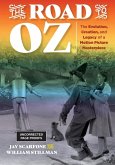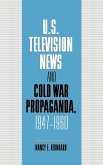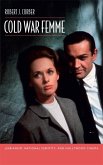The classic westerns read as fables
Though the United States emerged from World War II with superpower status and quickly entered a period of economic prosperity, the stresses and contradictions of the Cold War nevertheless cast a shadow over American life. The same period marked the heyday of the western film. Cowboys as Cold Warriors shows that this was no coincidence. It examines many of the significant westerns released between 1946 and 1962, analyzing how they responded to and influenced the cultural climate of the country.
Author Stanley Corkin discusses a dozen films in detail, connecting them to each other and to numerous others. He considers how these cultural productions both embellished the myth of the American frontier and reflected the era in which they were made.
Films discussed include: My Darling Clementine, Red River, Duel in the Sun, Pursued, Fort Apache, Broken Arrow, The Gunfighter, High Noon, Shane, The Searchers, Gunfight at the OK Corral, The Magnificent Seven, The Alamo, Lonely Are the Brave, Ride the High Country, and The Man Who Shot Liberty Valance. Author note: Stanley Corkin is Professor of English at the University of Cincinnati and author of Realism and the Birth of the Modern U.S.
"What makes Corkin's work unique is his focus on sixteen American films made between 1946 and 1962 and his argument that the evolution of the western genre during this period closely paralleled, influenced, and was influenced by changing official and popular American attitudes toward the cold war. Corkin's insights are persuasive." History
"Highly recommended" Choice
"Stanley Corkin brings a shrewd eye and a keen historical consciousness to this perceptive examination of the Hollywood Western in its glory days, exploring how these iconic films subtly addressed the global realignments, domestic tensions, and gender issues of the early Cold War era. Not only film buffs but everyone interested in mid-20th century U.S. politics and culture will enjoy and profit from this book." -Paul Boyer, author of By the Bomb's Early Light: American Thought and Culture at the Dawn of the Atomic Age
"Cowboys as Cold Warriors takes the reader on a galloping ride through the Western as meta-mythology. Corkin treats the films as the mapping of the American empire in the past, and a powerful metaphor for asserting its essential raison d'etre." -Lloyd Gardner, Rutgers University
Content:
Acknowledgments
Introduction: Westerns, U.S. History, and the Cold War
1. Cowboys, Free Markets, Wyatt Earp, and Thomas Dunson: My Darling Clementine and Red River
2. Melodrama and the Feminine Means to Empire: Duel in the Sun, Pursued, and Fort Apache
3. Cold War Westerns and the Law of the Gun: Broken Arrow and The Gunfighter
4. Korea, Containment, and Nationalism: High Noon, Shane, and The Searchers
5. Modernization Theory, Political Discord, and Intervention: Gunfight at the OK Corral, The Magnificent Seven, and The Alamo
6. Imperialist Nostalgia and the Road to Vietnam: Lonely Are the Brave, Ride the High Country, and The Man Who Shot Liberty Valance
Notes
Bibliography
Index
Though the United States emerged from World War II with superpower status and quickly entered a period of economic prosperity, the stresses and contradictions of the Cold War nevertheless cast a shadow over American life. The same period marked the heyday of the western film. Cowboys as Cold Warriors shows that this was no coincidence. It examines many of the significant westerns released between 1946 and 1962, analyzing how they responded to and influenced the cultural climate of the country.
Author Stanley Corkin discusses a dozen films in detail, connecting them to each other and to numerous others. He considers how these cultural productions both embellished the myth of the American frontier and reflected the era in which they were made.
Films discussed include: My Darling Clementine, Red River, Duel in the Sun, Pursued, Fort Apache, Broken Arrow, The Gunfighter, High Noon, Shane, The Searchers, Gunfight at the OK Corral, The Magnificent Seven, The Alamo, Lonely Are the Brave, Ride the High Country, and The Man Who Shot Liberty Valance. Author note: Stanley Corkin is Professor of English at the University of Cincinnati and author of Realism and the Birth of the Modern U.S.
"What makes Corkin's work unique is his focus on sixteen American films made between 1946 and 1962 and his argument that the evolution of the western genre during this period closely paralleled, influenced, and was influenced by changing official and popular American attitudes toward the cold war. Corkin's insights are persuasive." History
"Highly recommended" Choice
"Stanley Corkin brings a shrewd eye and a keen historical consciousness to this perceptive examination of the Hollywood Western in its glory days, exploring how these iconic films subtly addressed the global realignments, domestic tensions, and gender issues of the early Cold War era. Not only film buffs but everyone interested in mid-20th century U.S. politics and culture will enjoy and profit from this book." -Paul Boyer, author of By the Bomb's Early Light: American Thought and Culture at the Dawn of the Atomic Age
"Cowboys as Cold Warriors takes the reader on a galloping ride through the Western as meta-mythology. Corkin treats the films as the mapping of the American empire in the past, and a powerful metaphor for asserting its essential raison d'etre." -Lloyd Gardner, Rutgers University
Content:
Acknowledgments
Introduction: Westerns, U.S. History, and the Cold War
1. Cowboys, Free Markets, Wyatt Earp, and Thomas Dunson: My Darling Clementine and Red River
2. Melodrama and the Feminine Means to Empire: Duel in the Sun, Pursued, and Fort Apache
3. Cold War Westerns and the Law of the Gun: Broken Arrow and The Gunfighter
4. Korea, Containment, and Nationalism: High Noon, Shane, and The Searchers
5. Modernization Theory, Political Discord, and Intervention: Gunfight at the OK Corral, The Magnificent Seven, and The Alamo
6. Imperialist Nostalgia and the Road to Vietnam: Lonely Are the Brave, Ride the High Country, and The Man Who Shot Liberty Valance
Notes
Bibliography
Index








